Assessment: Ethical and Legal Requirements for Direct Client Care
VerifiedAdded on 2023/04/20
|39
|7835
|446
Homework Assignment
AI Summary
This assignment delves into the ethical and legal considerations essential for organizations providing care services. It addresses key areas such as managing children in the workplace, adhering to codes of conduct and practice, handling complaints, promoting continuing professional education, preventing discrimination, respecting the dignity of risk, fulfilling the duty of care, upholding human rights, obtaining informed consent, complying with mandatory reporting, meeting practice standards, maintaining practitioner/client boundaries, ensuring privacy and confidentiality, following policy frameworks, managing records, and understanding the rights and responsibilities of workers, employers, and clients. Furthermore, the assignment explains the consequences of breaching these ethical and legal considerations, emphasizing the importance of compliance within the healthcare industry to maintain trust, ensure patient safety, and avoid regulatory penalties.
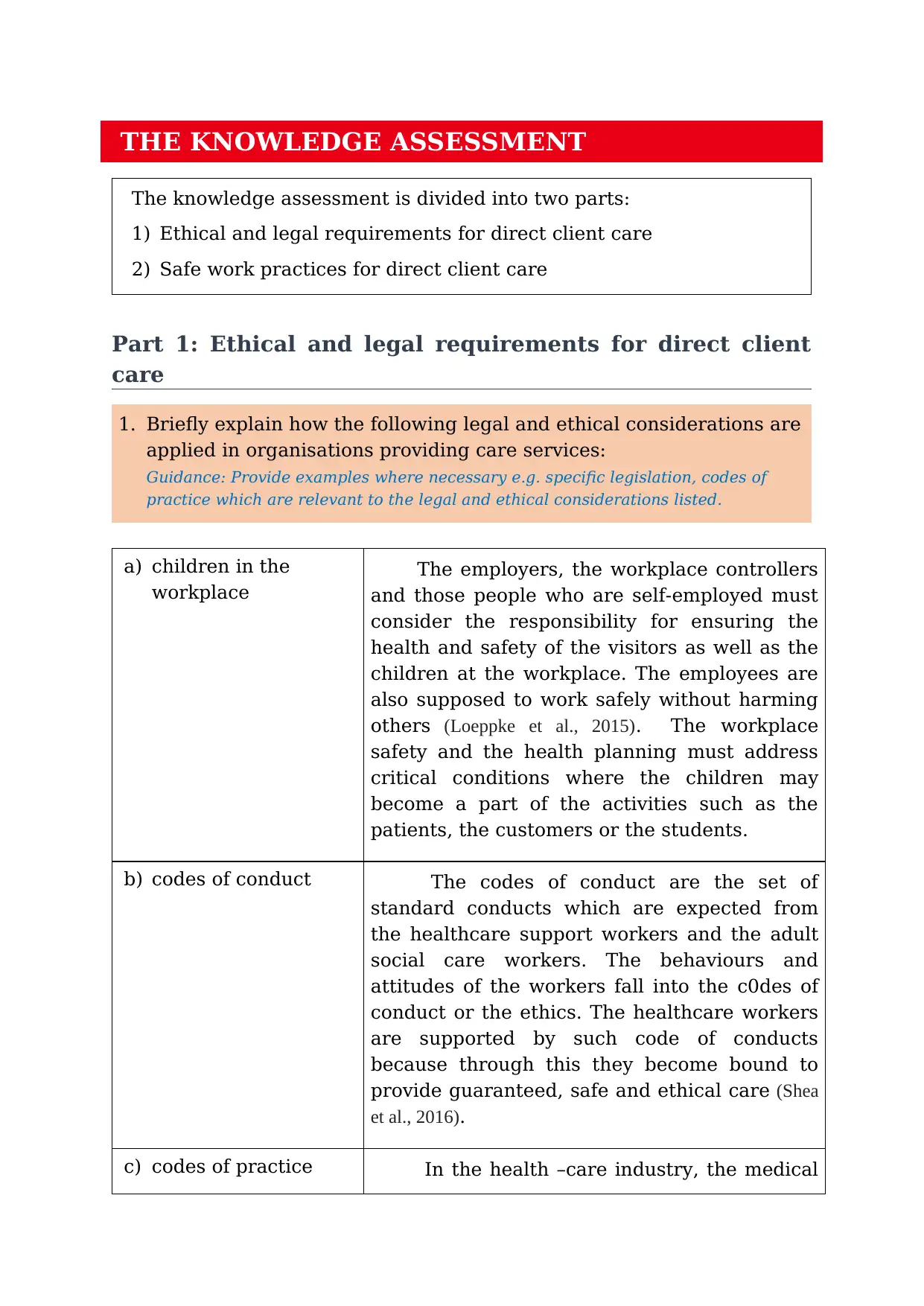
THE KNOWLEDGE ASSESSMENT
The knowledge assessment is divided into two parts:
1) Ethical and legal requirements for direct client care
2) Safe work practices for direct client care
Part 1: Ethical and legal requirements for direct client
care
1. Briefly explain how the following legal and ethical considerations are
applied in organisations providing care services:
Guidance: Provide examples where necessary e.g. specific legislation, codes of
practice which are relevant to the legal and ethical considerations listed.
a) children in the
workplace
The employers, the workplace controllers
and those people who are self-employed must
consider the responsibility for ensuring the
health and safety of the visitors as well as the
children at the workplace. The employees are
also supposed to work safely without harming
others (Loeppke et al., 2015). The workplace
safety and the health planning must address
critical conditions where the children may
become a part of the activities such as the
patients, the customers or the students.
b) codes of conduct The codes of conduct are the set of
standard conducts which are expected from
the healthcare support workers and the adult
social care workers. The behaviours and
attitudes of the workers fall into the c0des of
conduct or the ethics. The healthcare workers
are supported by such code of conducts
because through this they become bound to
provide guaranteed, safe and ethical care (Shea
et al., 2016).
c) codes of practice In the health –care industry, the medical
The knowledge assessment is divided into two parts:
1) Ethical and legal requirements for direct client care
2) Safe work practices for direct client care
Part 1: Ethical and legal requirements for direct client
care
1. Briefly explain how the following legal and ethical considerations are
applied in organisations providing care services:
Guidance: Provide examples where necessary e.g. specific legislation, codes of
practice which are relevant to the legal and ethical considerations listed.
a) children in the
workplace
The employers, the workplace controllers
and those people who are self-employed must
consider the responsibility for ensuring the
health and safety of the visitors as well as the
children at the workplace. The employees are
also supposed to work safely without harming
others (Loeppke et al., 2015). The workplace
safety and the health planning must address
critical conditions where the children may
become a part of the activities such as the
patients, the customers or the students.
b) codes of conduct The codes of conduct are the set of
standard conducts which are expected from
the healthcare support workers and the adult
social care workers. The behaviours and
attitudes of the workers fall into the c0des of
conduct or the ethics. The healthcare workers
are supported by such code of conducts
because through this they become bound to
provide guaranteed, safe and ethical care (Shea
et al., 2016).
c) codes of practice In the health –care industry, the medical
Paraphrase This Document
Need a fresh take? Get an instant paraphrase of this document with our AI Paraphraser
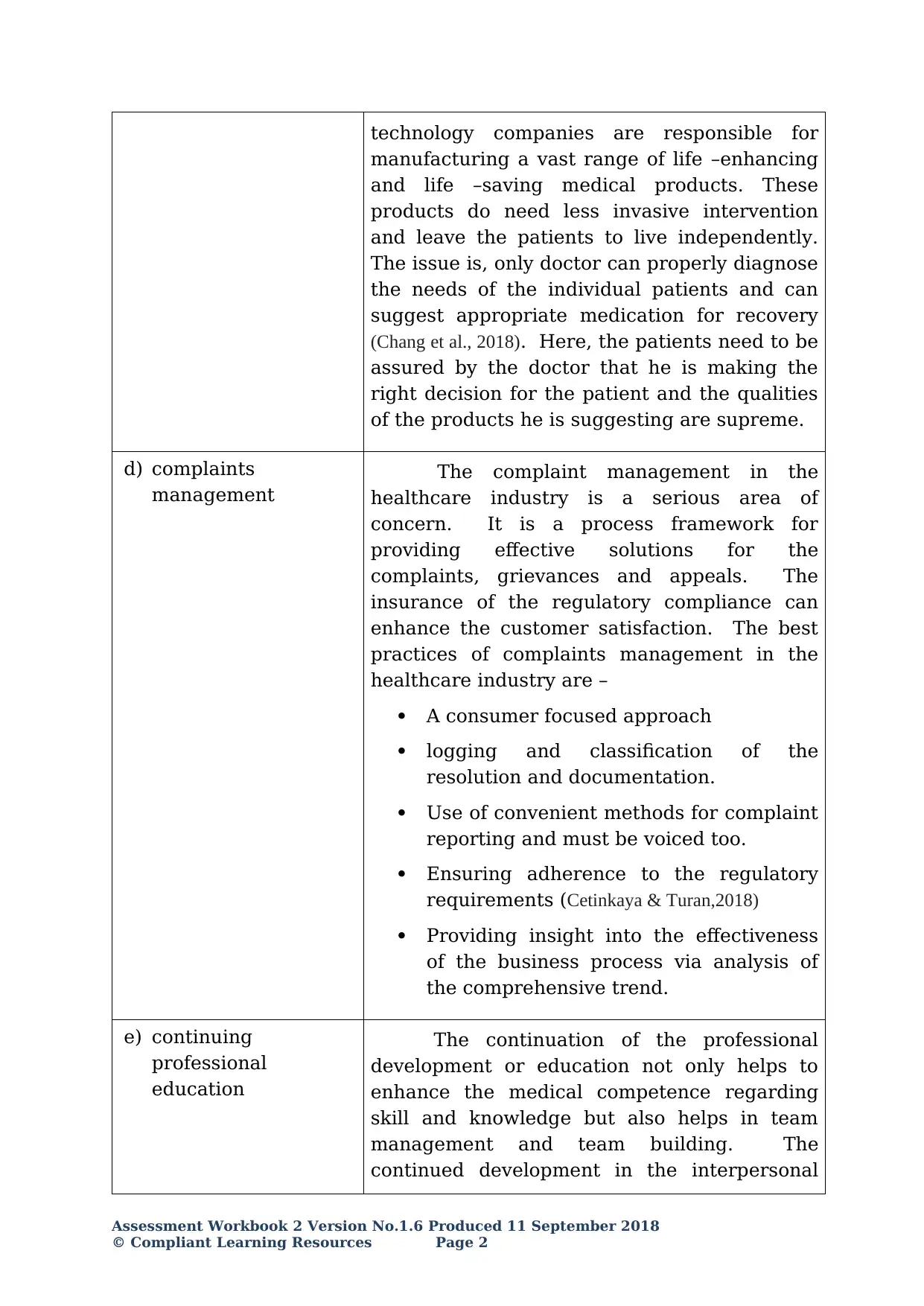
technology companies are responsible for
manufacturing a vast range of life –enhancing
and life –saving medical products. These
products do need less invasive intervention
and leave the patients to live independently.
The issue is, only doctor can properly diagnose
the needs of the individual patients and can
suggest appropriate medication for recovery
(Chang et al., 2018). Here, the patients need to be
assured by the doctor that he is making the
right decision for the patient and the qualities
of the products he is suggesting are supreme.
d) complaints
management
The complaint management in the
healthcare industry is a serious area of
concern. It is a process framework for
providing effective solutions for the
complaints, grievances and appeals. The
insurance of the regulatory compliance can
enhance the customer satisfaction. The best
practices of complaints management in the
healthcare industry are –
A consumer focused approach
logging and classification of the
resolution and documentation.
Use of convenient methods for complaint
reporting and must be voiced too.
Ensuring adherence to the regulatory
requirements (Cetinkaya & Turan,2018)
Providing insight into the effectiveness
of the business process via analysis of
the comprehensive trend.
e) continuing
professional
education
The continuation of the professional
development or education not only helps to
enhance the medical competence regarding
skill and knowledge but also helps in team
management and team building. The
continued development in the interpersonal
Assessment Workbook 2 Version No.1.6 Produced 11 September 2018
© Compliant Learning Resources Page 2
manufacturing a vast range of life –enhancing
and life –saving medical products. These
products do need less invasive intervention
and leave the patients to live independently.
The issue is, only doctor can properly diagnose
the needs of the individual patients and can
suggest appropriate medication for recovery
(Chang et al., 2018). Here, the patients need to be
assured by the doctor that he is making the
right decision for the patient and the qualities
of the products he is suggesting are supreme.
d) complaints
management
The complaint management in the
healthcare industry is a serious area of
concern. It is a process framework for
providing effective solutions for the
complaints, grievances and appeals. The
insurance of the regulatory compliance can
enhance the customer satisfaction. The best
practices of complaints management in the
healthcare industry are –
A consumer focused approach
logging and classification of the
resolution and documentation.
Use of convenient methods for complaint
reporting and must be voiced too.
Ensuring adherence to the regulatory
requirements (Cetinkaya & Turan,2018)
Providing insight into the effectiveness
of the business process via analysis of
the comprehensive trend.
e) continuing
professional
education
The continuation of the professional
development or education not only helps to
enhance the medical competence regarding
skill and knowledge but also helps in team
management and team building. The
continued development in the interpersonal
Assessment Workbook 2 Version No.1.6 Produced 11 September 2018
© Compliant Learning Resources Page 2
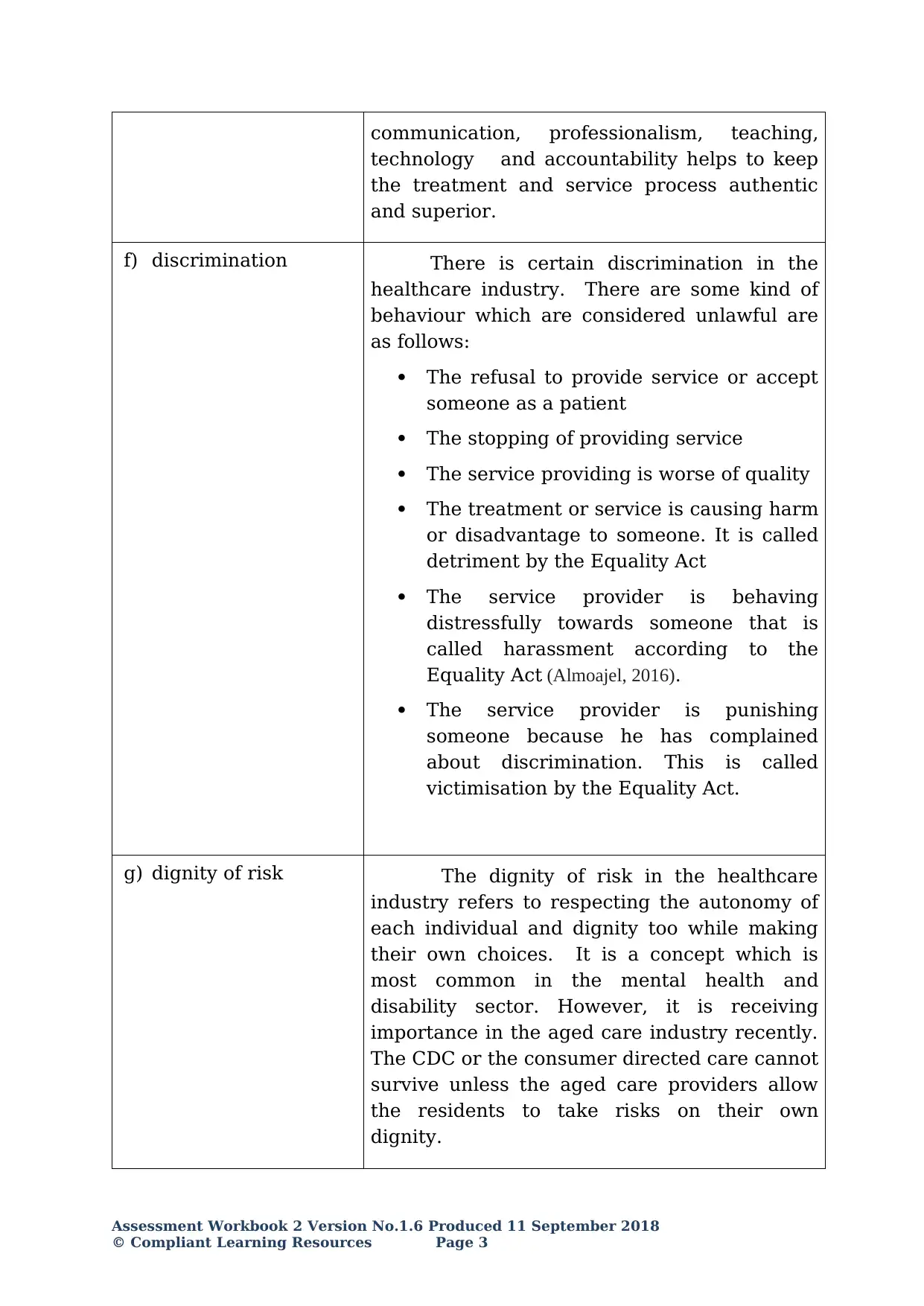
communication, professionalism, teaching,
technology and accountability helps to keep
the treatment and service process authentic
and superior.
f) discrimination There is certain discrimination in the
healthcare industry. There are some kind of
behaviour which are considered unlawful are
as follows:
The refusal to provide service or accept
someone as a patient
The stopping of providing service
The service providing is worse of quality
The treatment or service is causing harm
or disadvantage to someone. It is called
detriment by the Equality Act
The service provider is behaving
distressfully towards someone that is
called harassment according to the
Equality Act (Almoajel, 2016).
The service provider is punishing
someone because he has complained
about discrimination. This is called
victimisation by the Equality Act.
g) dignity of risk The dignity of risk in the healthcare
industry refers to respecting the autonomy of
each individual and dignity too while making
their own choices. It is a concept which is
most common in the mental health and
disability sector. However, it is receiving
importance in the aged care industry recently.
The CDC or the consumer directed care cannot
survive unless the aged care providers allow
the residents to take risks on their own
dignity.
Assessment Workbook 2 Version No.1.6 Produced 11 September 2018
© Compliant Learning Resources Page 3
technology and accountability helps to keep
the treatment and service process authentic
and superior.
f) discrimination There is certain discrimination in the
healthcare industry. There are some kind of
behaviour which are considered unlawful are
as follows:
The refusal to provide service or accept
someone as a patient
The stopping of providing service
The service providing is worse of quality
The treatment or service is causing harm
or disadvantage to someone. It is called
detriment by the Equality Act
The service provider is behaving
distressfully towards someone that is
called harassment according to the
Equality Act (Almoajel, 2016).
The service provider is punishing
someone because he has complained
about discrimination. This is called
victimisation by the Equality Act.
g) dignity of risk The dignity of risk in the healthcare
industry refers to respecting the autonomy of
each individual and dignity too while making
their own choices. It is a concept which is
most common in the mental health and
disability sector. However, it is receiving
importance in the aged care industry recently.
The CDC or the consumer directed care cannot
survive unless the aged care providers allow
the residents to take risks on their own
dignity.
Assessment Workbook 2 Version No.1.6 Produced 11 September 2018
© Compliant Learning Resources Page 3
⊘ This is a preview!⊘
Do you want full access?
Subscribe today to unlock all pages.

Trusted by 1+ million students worldwide
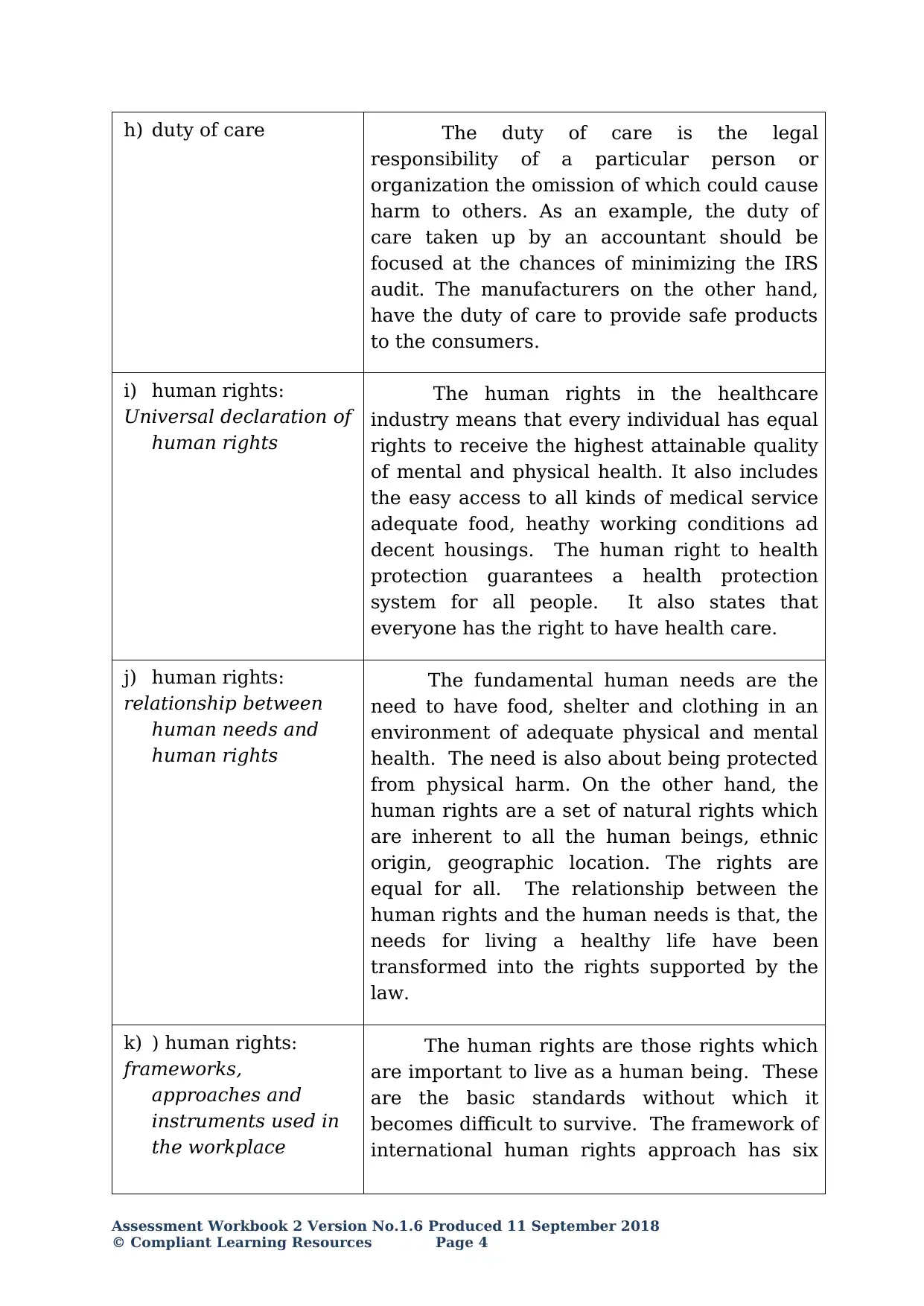
h) duty of care The duty of care is the legal
responsibility of a particular person or
organization the omission of which could cause
harm to others. As an example, the duty of
care taken up by an accountant should be
focused at the chances of minimizing the IRS
audit. The manufacturers on the other hand,
have the duty of care to provide safe products
to the consumers.
i) human rights:
Universal declaration of
human rights
The human rights in the healthcare
industry means that every individual has equal
rights to receive the highest attainable quality
of mental and physical health. It also includes
the easy access to all kinds of medical service
adequate food, heathy working conditions ad
decent housings. The human right to health
protection guarantees a health protection
system for all people. It also states that
everyone has the right to have health care.
j) human rights:
relationship between
human needs and
human rights
The fundamental human needs are the
need to have food, shelter and clothing in an
environment of adequate physical and mental
health. The need is also about being protected
from physical harm. On the other hand, the
human rights are a set of natural rights which
are inherent to all the human beings, ethnic
origin, geographic location. The rights are
equal for all. The relationship between the
human rights and the human needs is that, the
needs for living a healthy life have been
transformed into the rights supported by the
law.
k) ) human rights:
frameworks,
approaches and
instruments used in
the workplace
The human rights are those rights which
are important to live as a human being. These
are the basic standards without which it
becomes difficult to survive. The framework of
international human rights approach has six
Assessment Workbook 2 Version No.1.6 Produced 11 September 2018
© Compliant Learning Resources Page 4
responsibility of a particular person or
organization the omission of which could cause
harm to others. As an example, the duty of
care taken up by an accountant should be
focused at the chances of minimizing the IRS
audit. The manufacturers on the other hand,
have the duty of care to provide safe products
to the consumers.
i) human rights:
Universal declaration of
human rights
The human rights in the healthcare
industry means that every individual has equal
rights to receive the highest attainable quality
of mental and physical health. It also includes
the easy access to all kinds of medical service
adequate food, heathy working conditions ad
decent housings. The human right to health
protection guarantees a health protection
system for all people. It also states that
everyone has the right to have health care.
j) human rights:
relationship between
human needs and
human rights
The fundamental human needs are the
need to have food, shelter and clothing in an
environment of adequate physical and mental
health. The need is also about being protected
from physical harm. On the other hand, the
human rights are a set of natural rights which
are inherent to all the human beings, ethnic
origin, geographic location. The rights are
equal for all. The relationship between the
human rights and the human needs is that, the
needs for living a healthy life have been
transformed into the rights supported by the
law.
k) ) human rights:
frameworks,
approaches and
instruments used in
the workplace
The human rights are those rights which
are important to live as a human being. These
are the basic standards without which it
becomes difficult to survive. The framework of
international human rights approach has six
Assessment Workbook 2 Version No.1.6 Produced 11 September 2018
© Compliant Learning Resources Page 4
Paraphrase This Document
Need a fresh take? Get an instant paraphrase of this document with our AI Paraphraser
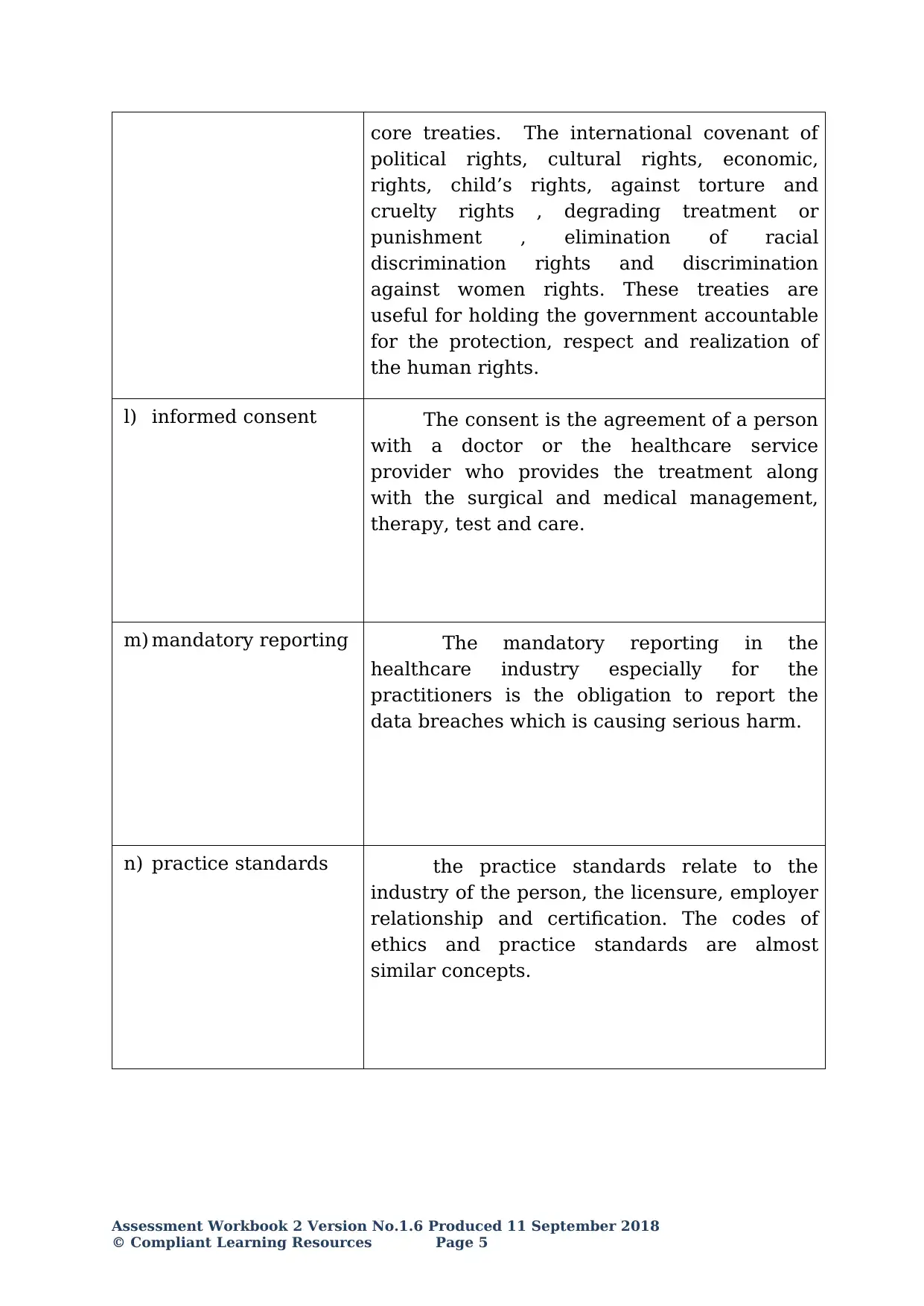
core treaties. The international covenant of
political rights, cultural rights, economic,
rights, child’s rights, against torture and
cruelty rights , degrading treatment or
punishment , elimination of racial
discrimination rights and discrimination
against women rights. These treaties are
useful for holding the government accountable
for the protection, respect and realization of
the human rights.
l) informed consent The consent is the agreement of a person
with a doctor or the healthcare service
provider who provides the treatment along
with the surgical and medical management,
therapy, test and care.
m) mandatory reporting The mandatory reporting in the
healthcare industry especially for the
practitioners is the obligation to report the
data breaches which is causing serious harm.
n) practice standards the practice standards relate to the
industry of the person, the licensure, employer
relationship and certification. The codes of
ethics and practice standards are almost
similar concepts.
Assessment Workbook 2 Version No.1.6 Produced 11 September 2018
© Compliant Learning Resources Page 5
political rights, cultural rights, economic,
rights, child’s rights, against torture and
cruelty rights , degrading treatment or
punishment , elimination of racial
discrimination rights and discrimination
against women rights. These treaties are
useful for holding the government accountable
for the protection, respect and realization of
the human rights.
l) informed consent The consent is the agreement of a person
with a doctor or the healthcare service
provider who provides the treatment along
with the surgical and medical management,
therapy, test and care.
m) mandatory reporting The mandatory reporting in the
healthcare industry especially for the
practitioners is the obligation to report the
data breaches which is causing serious harm.
n) practice standards the practice standards relate to the
industry of the person, the licensure, employer
relationship and certification. The codes of
ethics and practice standards are almost
similar concepts.
Assessment Workbook 2 Version No.1.6 Produced 11 September 2018
© Compliant Learning Resources Page 5
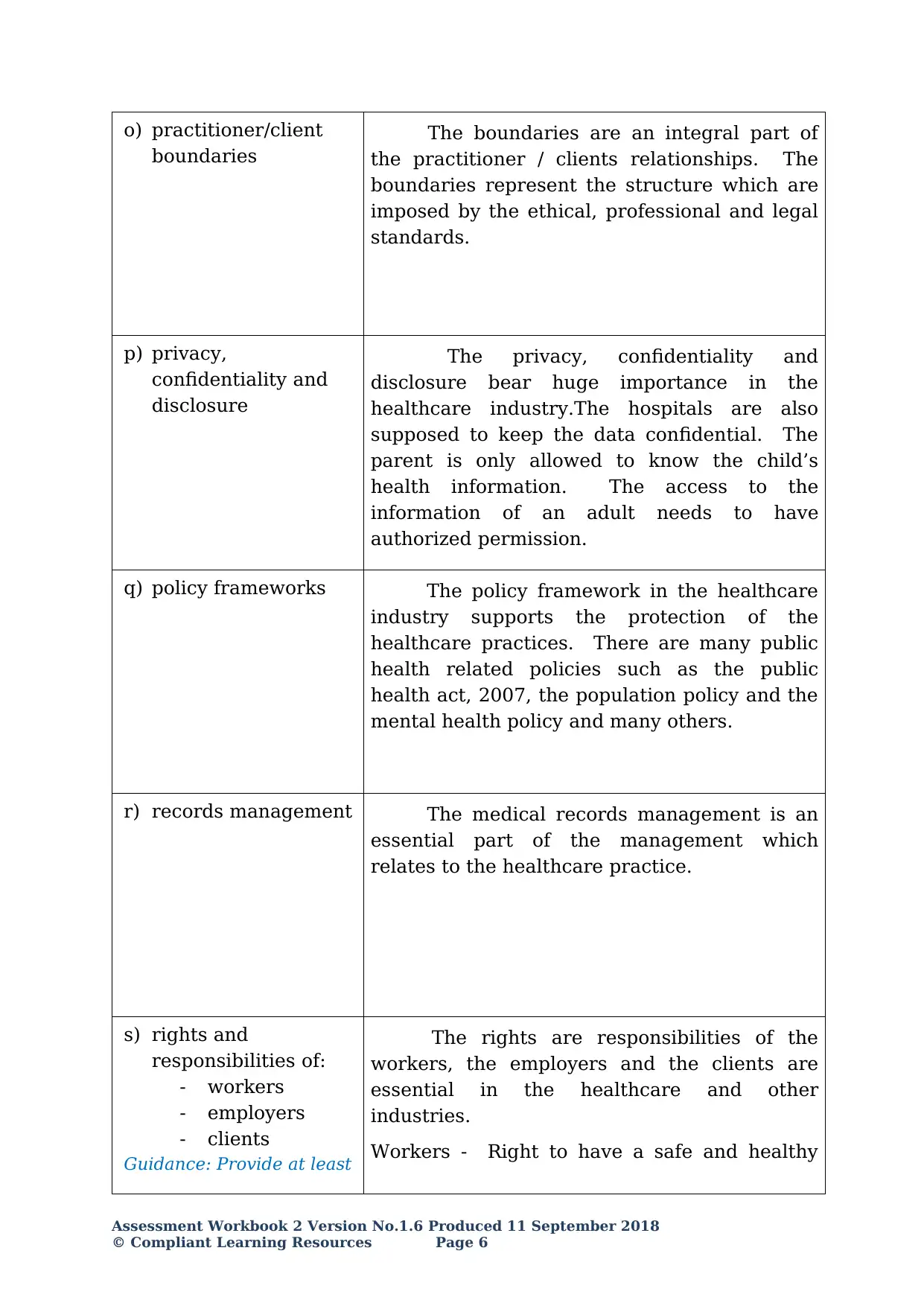
o) practitioner/client
boundaries
The boundaries are an integral part of
the practitioner / clients relationships. The
boundaries represent the structure which are
imposed by the ethical, professional and legal
standards.
p) privacy,
confidentiality and
disclosure
The privacy, confidentiality and
disclosure bear huge importance in the
healthcare industry.The hospitals are also
supposed to keep the data confidential. The
parent is only allowed to know the child’s
health information. The access to the
information of an adult needs to have
authorized permission.
q) policy frameworks The policy framework in the healthcare
industry supports the protection of the
healthcare practices. There are many public
health related policies such as the public
health act, 2007, the population policy and the
mental health policy and many others.
r) records management The medical records management is an
essential part of the management which
relates to the healthcare practice.
s) rights and
responsibilities of:
- workers
- employers
- clients
Guidance: Provide at least
The rights are responsibilities of the
workers, the employers and the clients are
essential in the healthcare and other
industries.
Workers - Right to have a safe and healthy
Assessment Workbook 2 Version No.1.6 Produced 11 September 2018
© Compliant Learning Resources Page 6
boundaries
The boundaries are an integral part of
the practitioner / clients relationships. The
boundaries represent the structure which are
imposed by the ethical, professional and legal
standards.
p) privacy,
confidentiality and
disclosure
The privacy, confidentiality and
disclosure bear huge importance in the
healthcare industry.The hospitals are also
supposed to keep the data confidential. The
parent is only allowed to know the child’s
health information. The access to the
information of an adult needs to have
authorized permission.
q) policy frameworks The policy framework in the healthcare
industry supports the protection of the
healthcare practices. There are many public
health related policies such as the public
health act, 2007, the population policy and the
mental health policy and many others.
r) records management The medical records management is an
essential part of the management which
relates to the healthcare practice.
s) rights and
responsibilities of:
- workers
- employers
- clients
Guidance: Provide at least
The rights are responsibilities of the
workers, the employers and the clients are
essential in the healthcare and other
industries.
Workers - Right to have a safe and healthy
Assessment Workbook 2 Version No.1.6 Produced 11 September 2018
© Compliant Learning Resources Page 6
⊘ This is a preview!⊘
Do you want full access?
Subscribe today to unlock all pages.

Trusted by 1+ million students worldwide
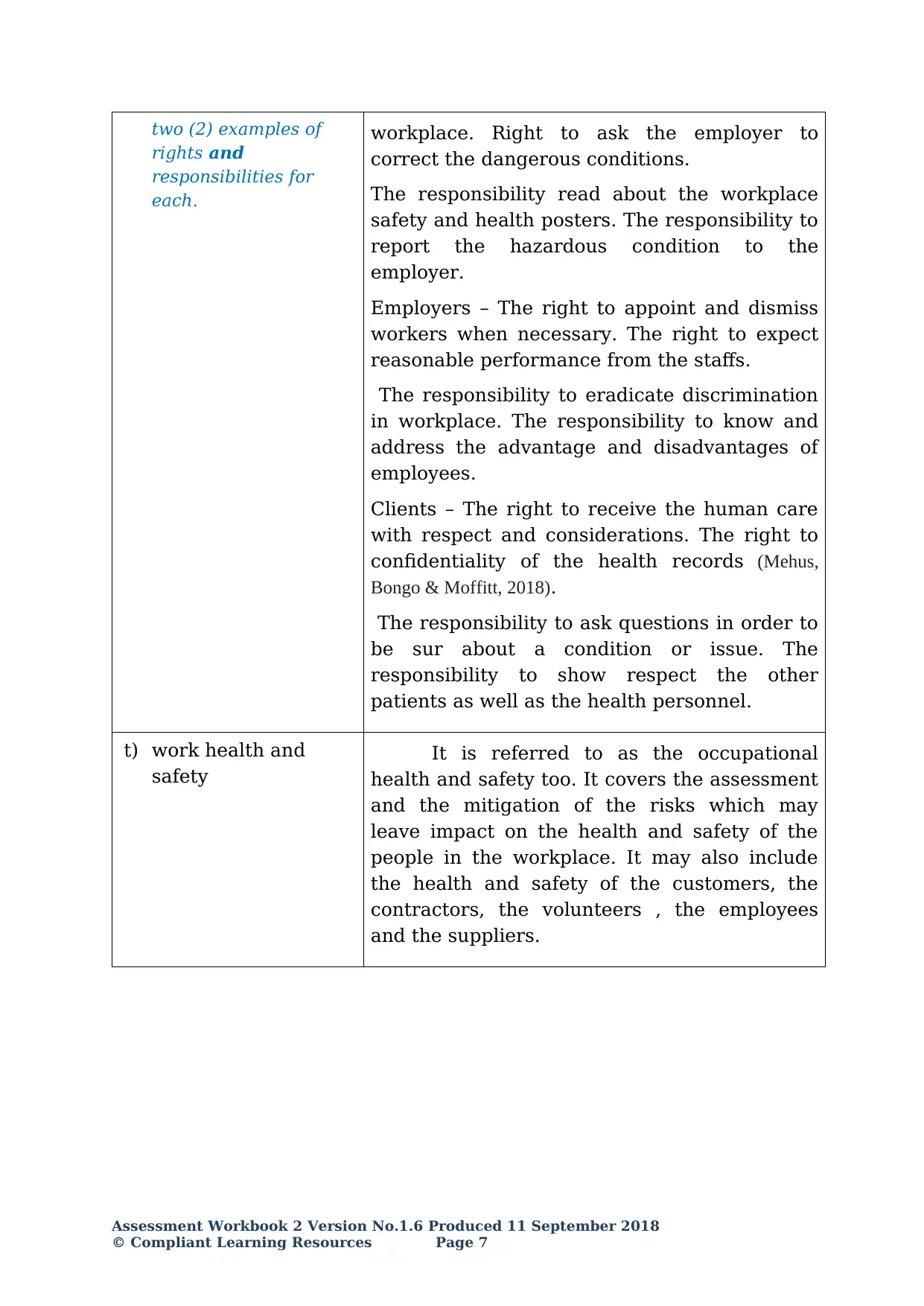
two (2) examples of
rights and
responsibilities for
each.
workplace. Right to ask the employer to
correct the dangerous conditions.
The responsibility read about the workplace
safety and health posters. The responsibility to
report the hazardous condition to the
employer.
Employers – The right to appoint and dismiss
workers when necessary. The right to expect
reasonable performance from the staffs.
The responsibility to eradicate discrimination
in workplace. The responsibility to know and
address the advantage and disadvantages of
employees.
Clients – The right to receive the human care
with respect and considerations. The right to
confidentiality of the health records (Mehus,
Bongo & Moffitt, 2018).
The responsibility to ask questions in order to
be sur about a condition or issue. The
responsibility to show respect the other
patients as well as the health personnel.
t) work health and
safety
It is referred to as the occupational
health and safety too. It covers the assessment
and the mitigation of the risks which may
leave impact on the health and safety of the
people in the workplace. It may also include
the health and safety of the customers, the
contractors, the volunteers , the employees
and the suppliers.
Assessment Workbook 2 Version No.1.6 Produced 11 September 2018
© Compliant Learning Resources Page 7
rights and
responsibilities for
each.
workplace. Right to ask the employer to
correct the dangerous conditions.
The responsibility read about the workplace
safety and health posters. The responsibility to
report the hazardous condition to the
employer.
Employers – The right to appoint and dismiss
workers when necessary. The right to expect
reasonable performance from the staffs.
The responsibility to eradicate discrimination
in workplace. The responsibility to know and
address the advantage and disadvantages of
employees.
Clients – The right to receive the human care
with respect and considerations. The right to
confidentiality of the health records (Mehus,
Bongo & Moffitt, 2018).
The responsibility to ask questions in order to
be sur about a condition or issue. The
responsibility to show respect the other
patients as well as the health personnel.
t) work health and
safety
It is referred to as the occupational
health and safety too. It covers the assessment
and the mitigation of the risks which may
leave impact on the health and safety of the
people in the workplace. It may also include
the health and safety of the customers, the
contractors, the volunteers , the employees
and the suppliers.
Assessment Workbook 2 Version No.1.6 Produced 11 September 2018
© Compliant Learning Resources Page 7
Paraphrase This Document
Need a fresh take? Get an instant paraphrase of this document with our AI Paraphraser
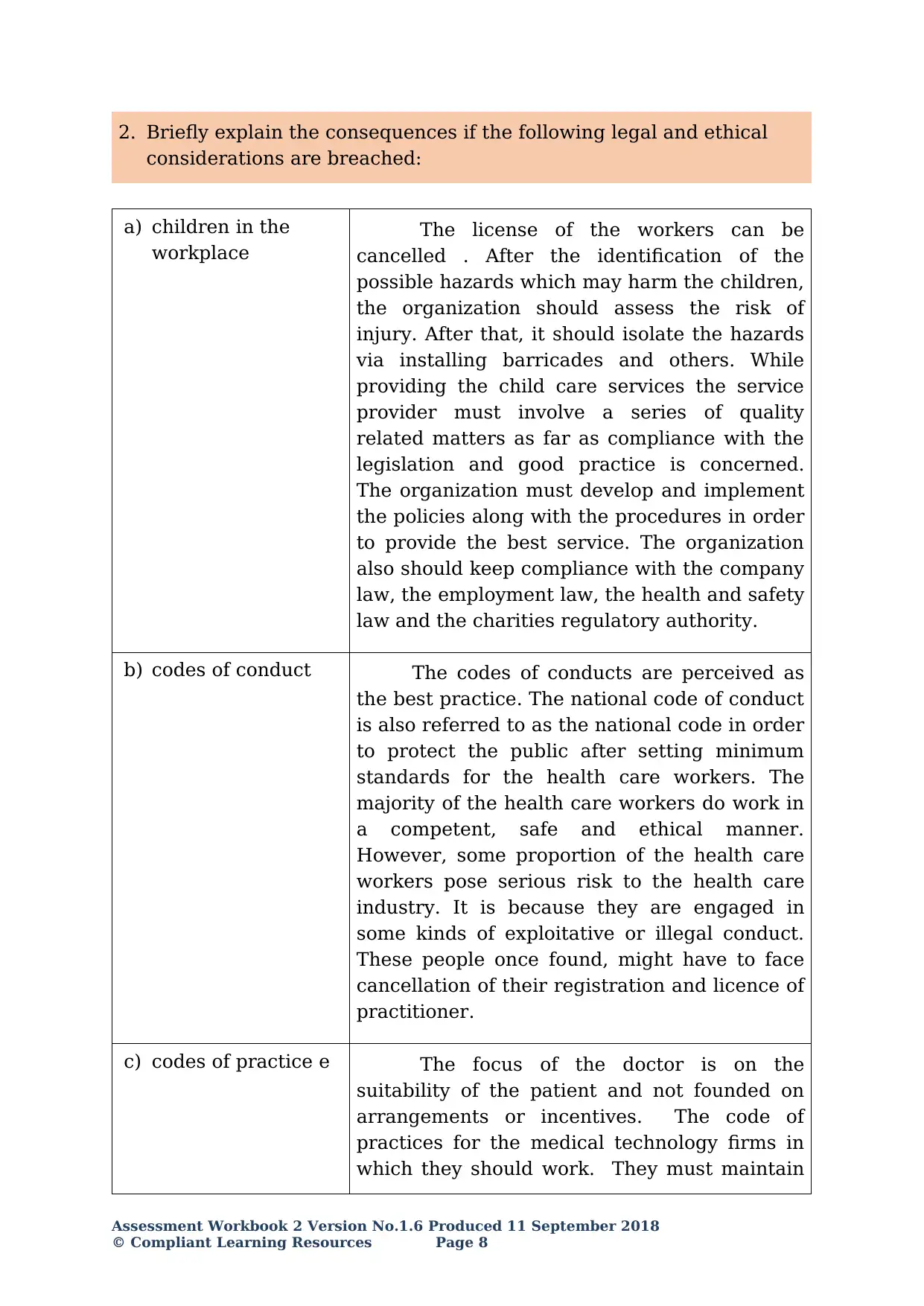
2. Briefly explain the consequences if the following legal and ethical
considerations are breached:
a) children in the
workplace
The license of the workers can be
cancelled . After the identification of the
possible hazards which may harm the children,
the organization should assess the risk of
injury. After that, it should isolate the hazards
via installing barricades and others. While
providing the child care services the service
provider must involve a series of quality
related matters as far as compliance with the
legislation and good practice is concerned.
The organization must develop and implement
the policies along with the procedures in order
to provide the best service. The organization
also should keep compliance with the company
law, the employment law, the health and safety
law and the charities regulatory authority.
b) codes of conduct The codes of conducts are perceived as
the best practice. The national code of conduct
is also referred to as the national code in order
to protect the public after setting minimum
standards for the health care workers. The
majority of the health care workers do work in
a competent, safe and ethical manner.
However, some proportion of the health care
workers pose serious risk to the health care
industry. It is because they are engaged in
some kinds of exploitative or illegal conduct.
These people once found, might have to face
cancellation of their registration and licence of
practitioner.
c) codes of practice e The focus of the doctor is on the
suitability of the patient and not founded on
arrangements or incentives. The code of
practices for the medical technology firms in
which they should work. They must maintain
Assessment Workbook 2 Version No.1.6 Produced 11 September 2018
© Compliant Learning Resources Page 8
considerations are breached:
a) children in the
workplace
The license of the workers can be
cancelled . After the identification of the
possible hazards which may harm the children,
the organization should assess the risk of
injury. After that, it should isolate the hazards
via installing barricades and others. While
providing the child care services the service
provider must involve a series of quality
related matters as far as compliance with the
legislation and good practice is concerned.
The organization must develop and implement
the policies along with the procedures in order
to provide the best service. The organization
also should keep compliance with the company
law, the employment law, the health and safety
law and the charities regulatory authority.
b) codes of conduct The codes of conducts are perceived as
the best practice. The national code of conduct
is also referred to as the national code in order
to protect the public after setting minimum
standards for the health care workers. The
majority of the health care workers do work in
a competent, safe and ethical manner.
However, some proportion of the health care
workers pose serious risk to the health care
industry. It is because they are engaged in
some kinds of exploitative or illegal conduct.
These people once found, might have to face
cancellation of their registration and licence of
practitioner.
c) codes of practice e The focus of the doctor is on the
suitability of the patient and not founded on
arrangements or incentives. The code of
practices for the medical technology firms in
which they should work. They must maintain
Assessment Workbook 2 Version No.1.6 Produced 11 September 2018
© Compliant Learning Resources Page 8
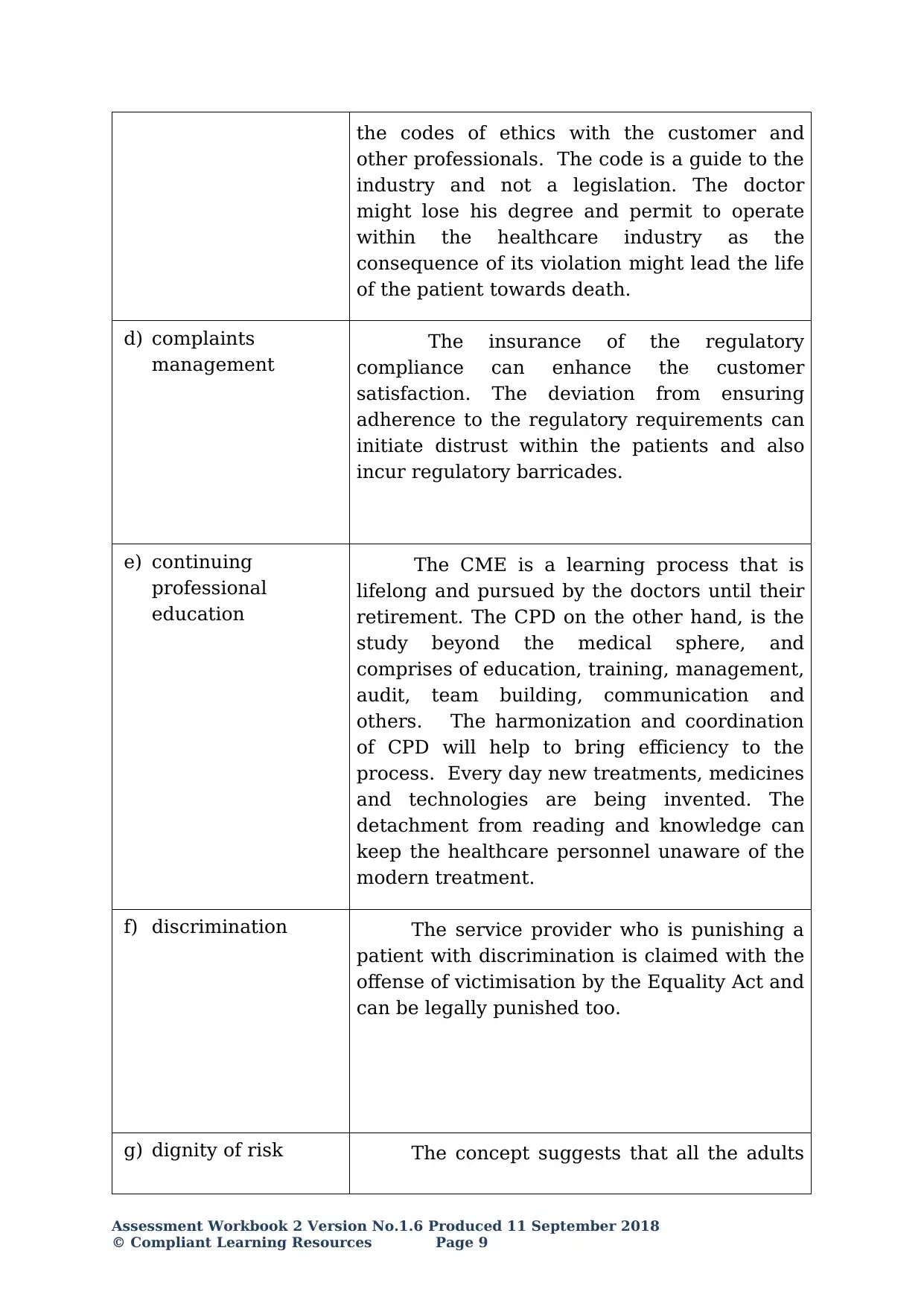
the codes of ethics with the customer and
other professionals. The code is a guide to the
industry and not a legislation. The doctor
might lose his degree and permit to operate
within the healthcare industry as the
consequence of its violation might lead the life
of the patient towards death.
d) complaints
management
The insurance of the regulatory
compliance can enhance the customer
satisfaction. The deviation from ensuring
adherence to the regulatory requirements can
initiate distrust within the patients and also
incur regulatory barricades.
e) continuing
professional
education
The CME is a learning process that is
lifelong and pursued by the doctors until their
retirement. The CPD on the other hand, is the
study beyond the medical sphere, and
comprises of education, training, management,
audit, team building, communication and
others. The harmonization and coordination
of CPD will help to bring efficiency to the
process. Every day new treatments, medicines
and technologies are being invented. The
detachment from reading and knowledge can
keep the healthcare personnel unaware of the
modern treatment.
f) discrimination The service provider who is punishing a
patient with discrimination is claimed with the
offense of victimisation by the Equality Act and
can be legally punished too.
g) dignity of risk The concept suggests that all the adults
Assessment Workbook 2 Version No.1.6 Produced 11 September 2018
© Compliant Learning Resources Page 9
other professionals. The code is a guide to the
industry and not a legislation. The doctor
might lose his degree and permit to operate
within the healthcare industry as the
consequence of its violation might lead the life
of the patient towards death.
d) complaints
management
The insurance of the regulatory
compliance can enhance the customer
satisfaction. The deviation from ensuring
adherence to the regulatory requirements can
initiate distrust within the patients and also
incur regulatory barricades.
e) continuing
professional
education
The CME is a learning process that is
lifelong and pursued by the doctors until their
retirement. The CPD on the other hand, is the
study beyond the medical sphere, and
comprises of education, training, management,
audit, team building, communication and
others. The harmonization and coordination
of CPD will help to bring efficiency to the
process. Every day new treatments, medicines
and technologies are being invented. The
detachment from reading and knowledge can
keep the healthcare personnel unaware of the
modern treatment.
f) discrimination The service provider who is punishing a
patient with discrimination is claimed with the
offense of victimisation by the Equality Act and
can be legally punished too.
g) dignity of risk The concept suggests that all the adults
Assessment Workbook 2 Version No.1.6 Produced 11 September 2018
© Compliant Learning Resources Page 9
⊘ This is a preview!⊘
Do you want full access?
Subscribe today to unlock all pages.

Trusted by 1+ million students worldwide
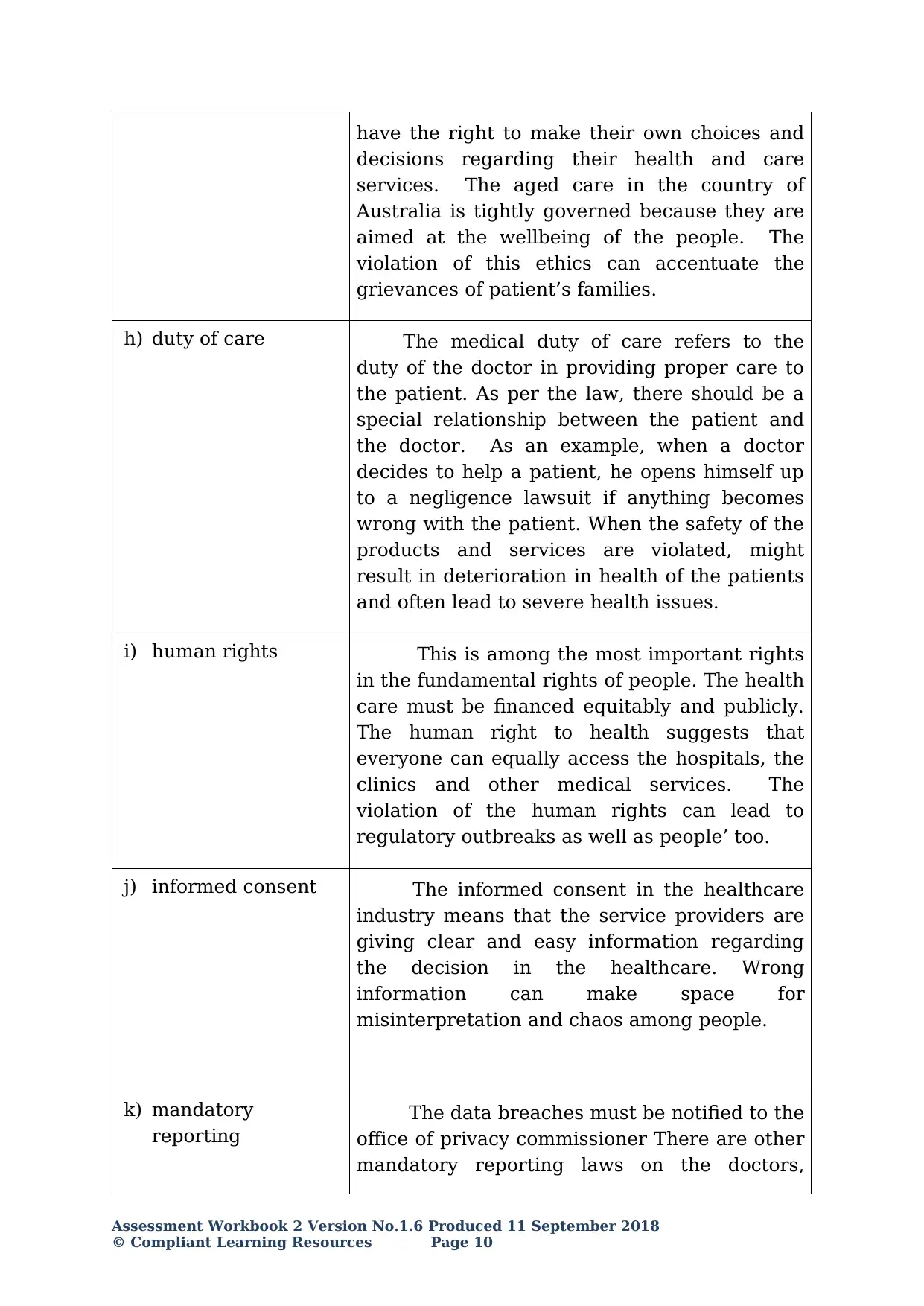
have the right to make their own choices and
decisions regarding their health and care
services. The aged care in the country of
Australia is tightly governed because they are
aimed at the wellbeing of the people. The
violation of this ethics can accentuate the
grievances of patient’s families.
h) duty of care The medical duty of care refers to the
duty of the doctor in providing proper care to
the patient. As per the law, there should be a
special relationship between the patient and
the doctor. As an example, when a doctor
decides to help a patient, he opens himself up
to a negligence lawsuit if anything becomes
wrong with the patient. When the safety of the
products and services are violated, might
result in deterioration in health of the patients
and often lead to severe health issues.
i) human rights This is among the most important rights
in the fundamental rights of people. The health
care must be financed equitably and publicly.
The human right to health suggests that
everyone can equally access the hospitals, the
clinics and other medical services. The
violation of the human rights can lead to
regulatory outbreaks as well as people’ too.
j) informed consent The informed consent in the healthcare
industry means that the service providers are
giving clear and easy information regarding
the decision in the healthcare. Wrong
information can make space for
misinterpretation and chaos among people.
k) mandatory
reporting
The data breaches must be notified to the
office of privacy commissioner There are other
mandatory reporting laws on the doctors,
Assessment Workbook 2 Version No.1.6 Produced 11 September 2018
© Compliant Learning Resources Page 10
decisions regarding their health and care
services. The aged care in the country of
Australia is tightly governed because they are
aimed at the wellbeing of the people. The
violation of this ethics can accentuate the
grievances of patient’s families.
h) duty of care The medical duty of care refers to the
duty of the doctor in providing proper care to
the patient. As per the law, there should be a
special relationship between the patient and
the doctor. As an example, when a doctor
decides to help a patient, he opens himself up
to a negligence lawsuit if anything becomes
wrong with the patient. When the safety of the
products and services are violated, might
result in deterioration in health of the patients
and often lead to severe health issues.
i) human rights This is among the most important rights
in the fundamental rights of people. The health
care must be financed equitably and publicly.
The human right to health suggests that
everyone can equally access the hospitals, the
clinics and other medical services. The
violation of the human rights can lead to
regulatory outbreaks as well as people’ too.
j) informed consent The informed consent in the healthcare
industry means that the service providers are
giving clear and easy information regarding
the decision in the healthcare. Wrong
information can make space for
misinterpretation and chaos among people.
k) mandatory
reporting
The data breaches must be notified to the
office of privacy commissioner There are other
mandatory reporting laws on the doctors,
Assessment Workbook 2 Version No.1.6 Produced 11 September 2018
© Compliant Learning Resources Page 10
Paraphrase This Document
Need a fresh take? Get an instant paraphrase of this document with our AI Paraphraser
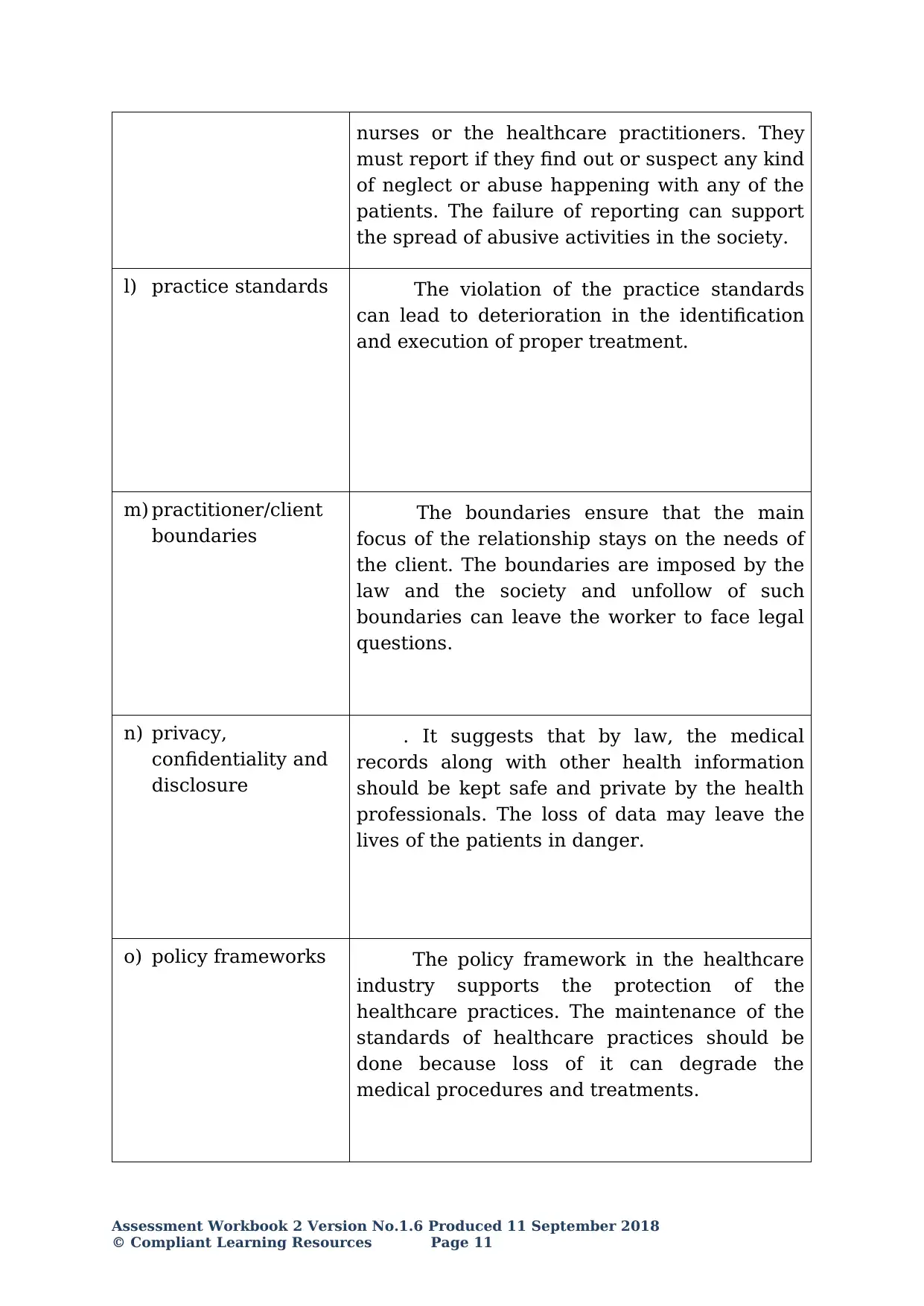
nurses or the healthcare practitioners. They
must report if they find out or suspect any kind
of neglect or abuse happening with any of the
patients. The failure of reporting can support
the spread of abusive activities in the society.
l) practice standards The violation of the practice standards
can lead to deterioration in the identification
and execution of proper treatment.
m) practitioner/client
boundaries
The boundaries ensure that the main
focus of the relationship stays on the needs of
the client. The boundaries are imposed by the
law and the society and unfollow of such
boundaries can leave the worker to face legal
questions.
n) privacy,
confidentiality and
disclosure
. It suggests that by law, the medical
records along with other health information
should be kept safe and private by the health
professionals. The loss of data may leave the
lives of the patients in danger.
o) policy frameworks The policy framework in the healthcare
industry supports the protection of the
healthcare practices. The maintenance of the
standards of healthcare practices should be
done because loss of it can degrade the
medical procedures and treatments.
Assessment Workbook 2 Version No.1.6 Produced 11 September 2018
© Compliant Learning Resources Page 11
must report if they find out or suspect any kind
of neglect or abuse happening with any of the
patients. The failure of reporting can support
the spread of abusive activities in the society.
l) practice standards The violation of the practice standards
can lead to deterioration in the identification
and execution of proper treatment.
m) practitioner/client
boundaries
The boundaries ensure that the main
focus of the relationship stays on the needs of
the client. The boundaries are imposed by the
law and the society and unfollow of such
boundaries can leave the worker to face legal
questions.
n) privacy,
confidentiality and
disclosure
. It suggests that by law, the medical
records along with other health information
should be kept safe and private by the health
professionals. The loss of data may leave the
lives of the patients in danger.
o) policy frameworks The policy framework in the healthcare
industry supports the protection of the
healthcare practices. The maintenance of the
standards of healthcare practices should be
done because loss of it can degrade the
medical procedures and treatments.
Assessment Workbook 2 Version No.1.6 Produced 11 September 2018
© Compliant Learning Resources Page 11
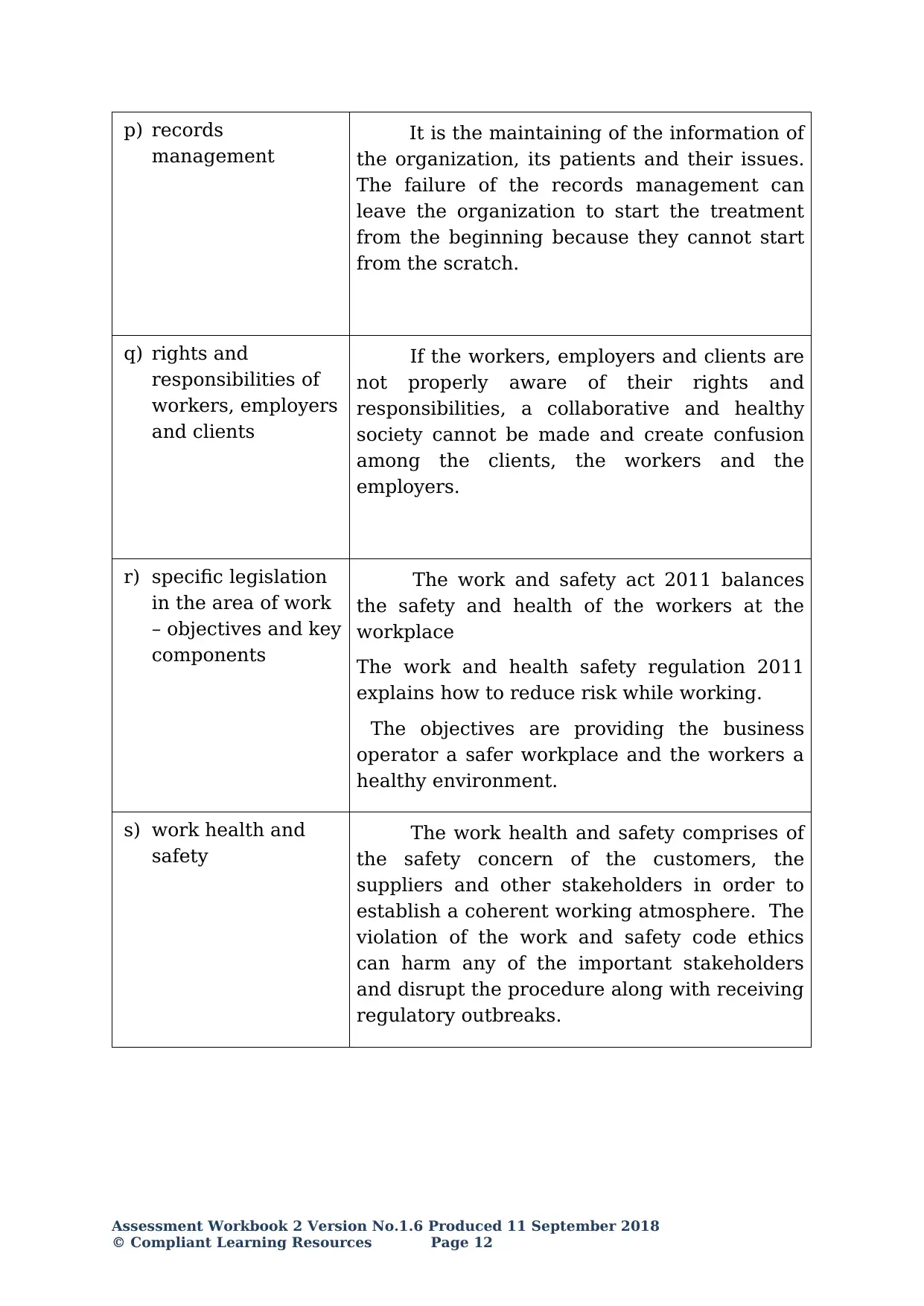
p) records
management
It is the maintaining of the information of
the organization, its patients and their issues.
The failure of the records management can
leave the organization to start the treatment
from the beginning because they cannot start
from the scratch.
q) rights and
responsibilities of
workers, employers
and clients
If the workers, employers and clients are
not properly aware of their rights and
responsibilities, a collaborative and healthy
society cannot be made and create confusion
among the clients, the workers and the
employers.
r) specific legislation
in the area of work
– objectives and key
components
The work and safety act 2011 balances
the safety and health of the workers at the
workplace
The work and health safety regulation 2011
explains how to reduce risk while working.
The objectives are providing the business
operator a safer workplace and the workers a
healthy environment.
s) work health and
safety
The work health and safety comprises of
the safety concern of the customers, the
suppliers and other stakeholders in order to
establish a coherent working atmosphere. The
violation of the work and safety code ethics
can harm any of the important stakeholders
and disrupt the procedure along with receiving
regulatory outbreaks.
Assessment Workbook 2 Version No.1.6 Produced 11 September 2018
© Compliant Learning Resources Page 12
management
It is the maintaining of the information of
the organization, its patients and their issues.
The failure of the records management can
leave the organization to start the treatment
from the beginning because they cannot start
from the scratch.
q) rights and
responsibilities of
workers, employers
and clients
If the workers, employers and clients are
not properly aware of their rights and
responsibilities, a collaborative and healthy
society cannot be made and create confusion
among the clients, the workers and the
employers.
r) specific legislation
in the area of work
– objectives and key
components
The work and safety act 2011 balances
the safety and health of the workers at the
workplace
The work and health safety regulation 2011
explains how to reduce risk while working.
The objectives are providing the business
operator a safer workplace and the workers a
healthy environment.
s) work health and
safety
The work health and safety comprises of
the safety concern of the customers, the
suppliers and other stakeholders in order to
establish a coherent working atmosphere. The
violation of the work and safety code ethics
can harm any of the important stakeholders
and disrupt the procedure along with receiving
regulatory outbreaks.
Assessment Workbook 2 Version No.1.6 Produced 11 September 2018
© Compliant Learning Resources Page 12
⊘ This is a preview!⊘
Do you want full access?
Subscribe today to unlock all pages.

Trusted by 1+ million students worldwide
1 out of 39
Related Documents
Your All-in-One AI-Powered Toolkit for Academic Success.
+13062052269
info@desklib.com
Available 24*7 on WhatsApp / Email
![[object Object]](/_next/static/media/star-bottom.7253800d.svg)
Unlock your academic potential
Copyright © 2020–2025 A2Z Services. All Rights Reserved. Developed and managed by ZUCOL.





